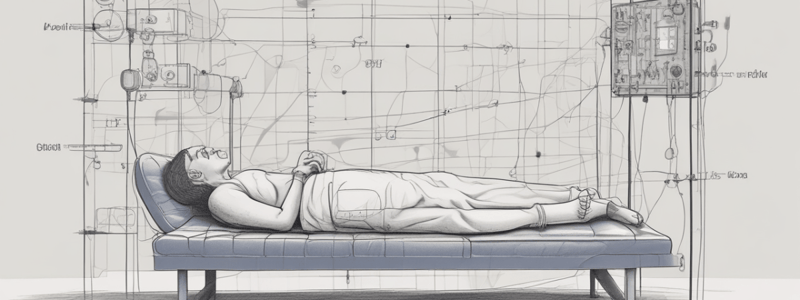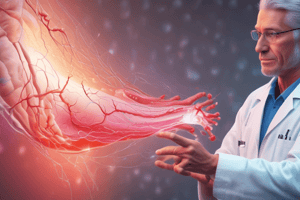Podcast
Questions and Answers
What is the recommended train-of-four ratio before extubation to reduce residual neuromuscular blockade?
What is the recommended train-of-four ratio before extubation to reduce residual neuromuscular blockade?
- 0.9 (correct)
- 0.1
- 0.5
- 1.2
In which range of train-of-four ratio is Neostigmine considered a reasonable alternative for antagonism?
In which range of train-of-four ratio is Neostigmine considered a reasonable alternative for antagonism?
- 0.4 to less than 0.9 (correct)
- 0.9 to 1.2
- 1.0 to 1.5
- 0.1 to 0.3
What type of recovery in the train-of-four ratio indicates patients do not require pharmacological antagonism?
What type of recovery in the train-of-four ratio indicates patients do not require pharmacological antagonism?
- Exactly 1.0
- Less than 0.4
- Greater than or equal to 0.9 (correct)
- Between 0.5 and 0.8
Where is quantitative neuromuscular monitoring recommended as per the guideline?
Where is quantitative neuromuscular monitoring recommended as per the guideline?
Which type of neuromuscular block can Sugammadex be used for according to the guideline?
Which type of neuromuscular block can Sugammadex be used for according to the guideline?
Why is monitoring succinylcholine block unique compared to other neuromuscular blockers?
Why is monitoring succinylcholine block unique compared to other neuromuscular blockers?
Which neuromuscular blocker is a known trigger for malignant hyperthermia?
Which neuromuscular blocker is a known trigger for malignant hyperthermia?
What may result from an increase in 'immature' forms of nicotinic acetylcholine receptors following administration of a depolarizing neuromuscular blocker?
What may result from an increase in 'immature' forms of nicotinic acetylcholine receptors following administration of a depolarizing neuromuscular blocker?
Why is the routine use of succinylcholine in otherwise healthy children contraindicated?
Why is the routine use of succinylcholine in otherwise healthy children contraindicated?
Which patients are more likely to experience partial paralysis according to the text?
Which patients are more likely to experience partial paralysis according to the text?
What is associated with the prolonged use of neuromuscular blockers in the ICU?
What is associated with the prolonged use of neuromuscular blockers in the ICU?
What should be used when neuromuscular blockade is necessary in the ICU?
What should be used when neuromuscular blockade is necessary in the ICU?
Are adequate intubating conditions usually attainable without the use of neuromuscular blockers?
Are adequate intubating conditions usually attainable without the use of neuromuscular blockers?
What does the presence of fade with repetitive stimulation indicate in monitoring non-depolarizing block?
What does the presence of fade with repetitive stimulation indicate in monitoring non-depolarizing block?
How do volatile anesthetics affect neuromuscular blockers?
How do volatile anesthetics affect neuromuscular blockers?
Why is clinical assessment of recovery from neuromuscular blockade considered unreliable?
Why is clinical assessment of recovery from neuromuscular blockade considered unreliable?
What happens when an anticholinesterase is used to antagonize non-depolarizing neuromuscular blockers?
What happens when an anticholinesterase is used to antagonize non-depolarizing neuromuscular blockers?
What is the purpose of pairing anticholinesterases with antimuscarinics for reversal of neuromuscular blockade?
What is the purpose of pairing anticholinesterases with antimuscarinics for reversal of neuromuscular blockade?
Why does using a nerve stimulator alone increase the likelihood of residual paralysis?
Why does using a nerve stimulator alone increase the likelihood of residual paralysis?
What is the primary mechanism of action of succinylcholine at the neuromuscular junction?
What is the primary mechanism of action of succinylcholine at the neuromuscular junction?
Which type of blockade is most likely to occur with a large bolus dose of succinylcholine?
Which type of blockade is most likely to occur with a large bolus dose of succinylcholine?
What is the primary factor contributing to the duration of action of succinylcholine?
What is the primary factor contributing to the duration of action of succinylcholine?
In which type of muscle would one primarily find the expression of ε receptors?
In which type of muscle would one primarily find the expression of ε receptors?
Which condition is primarily associated with an increase in immature α7 nicotinic Ach receptors?
Which condition is primarily associated with an increase in immature α7 nicotinic Ach receptors?
What is the primary effect of upregulation of immature receptor types on non-depolarizing neuromuscular blockers?
What is the primary effect of upregulation of immature receptor types on non-depolarizing neuromuscular blockers?
Resistance to succinylcholine is primarily associated with which type of receptor regulation?
Resistance to succinylcholine is primarily associated with which type of receptor regulation?
Which drug metabolism process occurs en route to and after diffusion away from the neuromuscular junction?
Which drug metabolism process occurs en route to and after diffusion away from the neuromuscular junction?
Flashcards are hidden until you start studying
Study Notes
Neuromuscular Blockers and Reversal
- The 2023 ASA Practice Guidelines provide evidence-based recommendations for managing neuromuscular monitoring and antagonism of neuromuscular blocking agents.
- The objective is to enhance patient safety by reducing residual neuromuscular blockade.
Neuromuscular Blockers Classification
- Neuromuscular blockers are classified based on onset and duration of action.
- Depolarizing neuromuscular blockers (e.g., succinylcholine) act like acetylcholine, opening a channel that allows Na+ influx and K+ efflux, resulting in depolarization of the postsynaptic membrane.
- Non-depolarizing neuromuscular blockers (e.g., aminosteroids, isoquinoliniums) act via competitive antagonism of ACh binding to the NAChR.
Succinylcholine
- Succinylcholine results in the fastest onset with the least variability and shortest duration of the NMBs.
- Monitoring of succinylcholine block reveals no fade on train-of-four monitoring and no post-tetanic facilitation.
- Succinylcholine is a trigger for malignant hyperthermia, which may occur due to a mutation in the ryanodine receptor, resulting in excessive calcium release.
Neuromuscular Blockade Monitoring
- Neuromuscular monitoring should be used in the ICU when neuromuscular blockade is necessary.
- Periodic return of muscle function should be allowed to prevent prolonged use of neuromuscular blockers.
- Clinical assessment of recovery from neuromuscular blockade is unreliable and predisposes the patient to residual postoperative neuromuscular blockade and morbidity.
Reversal of Neuromuscular Blockade
- Anticholinesterases (e.g., neostigmine) increase ACh levels at the NMJ to compete with the NMB drug for the alpha subunit of the NAChR.
- The selective relaxant binding agent (SRBA) sugammadex encapsulates and renders ineffective the aminosteroidal NMBs, particularly rocuronium and vecuronium.
- Sugammadex changes the way we think about a difficult airway scenario, CICO, and certain neuromuscular disorders, as recovery from neuromuscular block with rocuronium and sugammadex may be more rapid than spontaneous recovery from succinylcholine.
Importance of Reversal
- Inadequate reversal of muscle relaxant at the conclusion of surgery has significant consequences for patients.
- Prolonged use of neuromuscular blockade in the ICU is associated with multiple concerns, including myopathy, polyneuropathy, and the potential for hyperkalemic arrest following the use of succinylcholine for emergent reintubation.
Studying That Suits You
Use AI to generate personalized quizzes and flashcards to suit your learning preferences.




